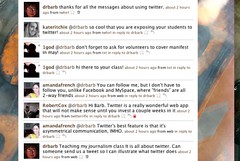Safeguarding: the next step in the transition to Web 3.0?

- Image via Wikipedia
I’m worried about ownership. I’m concerned about ‘intellectual property’. There’s two statements I never thought I’d make on this blog! Why am I thinking about these two topics? It’s a result of a combination of three things that have happened recently:
- The release of WordPress 2.7 that has made my use of the Disqus commenting system on this blog largely redundant. I’m now wondering why I’m using it as the comments aren’t backed up along with my blog posts. What if Disqus goes paid-for or bust? 😮
- TeachMeet09 at BETT was great. But what’s stopping people taking the name and patenting it, thereby trading off all the great (and free) work educators have done?
- Dai Barnes registered edtechroundup.co.uk last week to test out Jumpbox. Whilst that’s great and was fine, what was to stop someone else registering that name and spamming it?
So I suppose what I’m concerned about isn’t ‘ownership’ or ‘intellectual property’ at all, it’s safeguarding. To my mind, that’s something that’s got to be sorted out before we move from what has been called Web 2.0:
The second generation of the World Wide Web, especially the movement away from static webpages to dynamic and shareable content.
…to what, for the time being is known as Web 3.0 or the ‘semantic web’:
Web 3.0… refers to a supposed third generation of Internet-based services that collectively comprise what might be called ‘the intelligent Web’—such as those using semantic web, microformats, natural language search, data mining, machine learning, recommendation agents, and artificial intelligence technologies—which emphasize machine-facilitated understanding of information in order to provide a more productive and intuitive user experience.
For ‘intelligent agents’ and semantic web searches to be possible, there has to be an understanding of the relationship between spaces and identities on the Internet. There is an element of this with the FOAF (‘Friend Of A Friend’) protocol included in web applications and software such as WordPress, which powers this blog.
It’s going to be difficult to weigh-up and balance on the one hand, making sure that brands, identities and ideas aren’t hijacked, whilst on the other, giving individuals and groups freedom of expression. But without some change in safeguarding, I can’t see the change happening anytime soon.
Who’s going to be the guarddog that provides guarantees? Or can it be distributed?
Related articles by Zemanta (on other blogs)
- Disqus Gives Spammers A DoFollow Thanksgiving Feast
- Discussing DISQUS
- Academic Worldwide knowledge is “migrating” to Slovenia
- Biometric identifcation by body language
- Disqus blog comment system adds trackbacks: Will it be enough?
- An Explanation of the Semantic Web
- GenderAnalyzer.com – Who Is That Writing?
- Computers want to learn too

![Reblog this post [with Zemanta]](http://img.zemanta.com/reblog_e.png?x-id=88d1e0a0-b298-498a-8f07-6039f638a65e)

![Reblog this post [with Zemanta]](http://img.zemanta.com/reblog_e.png?x-id=a22f5c18-1559-4cec-9544-44b892a86106)
 I’ve spent this afternoon and early evening at a ‘tweetmeet’. These are also known as ‘tweetups’ and are when people who have previously only met, or usually communicate, through the microblogging service Twitter meet up face-to-face. I’d actually met
I’ve spent this afternoon and early evening at a ‘tweetmeet’. These are also known as ‘tweetups’ and are when people who have previously only met, or usually communicate, through the microblogging service Twitter meet up face-to-face. I’d actually met  Michael Thompson, author of
Michael Thompson, author of 
![Reblog this post [with Zemanta]](http://img.zemanta.com/reblog_e.png?x-id=1b66070c-4dc5-47a3-ba33-2301c3ee4ed2)